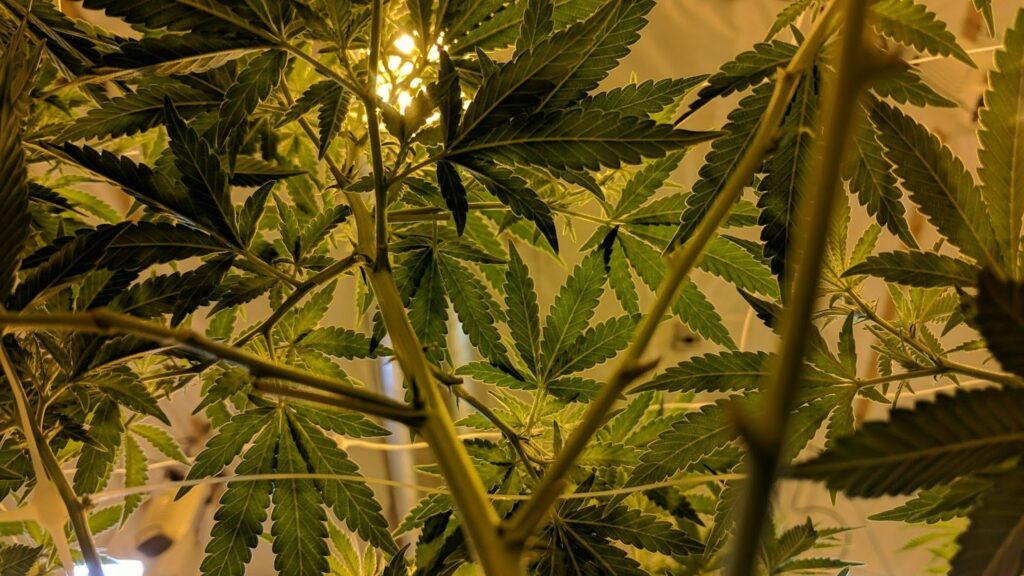Have you noticed your cannabis plant showing signs of stress, such as yellowing leaves, stunted growth, or twisted, distorted foliage? You’ve been following your usual feeding routine, providing the proper nutrients, and keeping the environment ideal.
So why is your plant still struggling? The answer could be a nutrient lockout.
Nutrient lockout occurs when your plant has access to nutrients but cannot take them from the soil or nutrient solution.
It results from various causes, ranging from pH imbalances to salt buildup. It may cause nutrient deficiencies, poor growth, and weak plant health.
The worst part is that your plant may seem to have everything it needs to grow, but it is just unable to obtain any of it.
The good news is that nutrient lockout is treatable. With the proper knowledge, you can fix the issue and save your cannabis plant.
In this article, we will explore the concept of nutrient lockout, how to identify its symptoms, and the steps you can take to fix it and prevent it from happening again.
What is Nutrient Lockout?
A nutrient lockout occurs when your cannabis plants can’t access the vital nutrients they need to thrive despite the availability of those nutrients in the soil or a nutrient solution.
The nutrients are there, but the plant can’t access them due to the environment. pH imbalances, excessive salt buildup, and bad watering practices are the most common causes of nutrient lockout.
These factors change how the plant absorbs nutrients, leading to deficiencies even though all the nutrients are present but not in a form that allows the plant to absorb and utilize them.
For instance, if the pH of your soil or water is too extreme, either too high or too low, it can interfere with the solubility of some nutrients in the plant.
Similarly, if the plant is overfertilized, salt build-up around the roots can cause this; water will be diverted away from the plant, denying it the nutrients it is trying to absorb.
Likewise, nutrient lockout can occur as the roots become waterlogged and oxygen-starved when one overwaters.
Due to nutrient lockout, your cannabis plant might display deficiency symptoms like yellowing leaves, stunted growth, and general poor health.
If not corrected, the nutrient lockout may result in more serious problems like imbalances of nutrients, irreparable damage to the plant, and even death.
Therefore, it is essential to understand that nutrient lockout is not a deficiency. In a deficiency, the plant does not obtain adequate amounts of a specific nutrient because it is absent from the environment.
However, in this case, lockout nutrients are present; only the plant can’t access them because of environmental conditions.
So, what are the causes of nutrient lockout? Let us explore.
Causes of Nutrient Lockout
A series of factors cause a nutrient lockout, which disables the plant’s ability to absorb the needed nutrients. These causes form the basis for diagnosing and remedying the condition before it causes plant problems. Here are some of them:
- Unfavorable pH Values: Your soil or water pH is outside the preferred range: 6.0-7.0 for soil and 5.5-6.5 for hydroponics.
- Salinity from Overfertilization: Overusing fertilizer causes excessive salt levels, which makes it challenging for your plant to absorb water and nutrients. Overfertilization may also cause dehydration.
- Waterlogged Soil: Too much water creates oversaturated roots, minimizing oxygen availability. This encourages salt accumulation, which prevents nutrient uptake.
- Poor Nutrient Ratio Too much of one nutrient (such as calcium or nitrogen) can prevent the roots from absorbing other nutrients, including magnesium and phosphorus.
- Poor Drainage: This is caused by poor drainage. Water can collect around the roots, drowning them or making nutrient uptake difficult.
- Root Damage/Disease: Damaged roots or those with diseases cannot absorb nutrients appropriately, resulting in lockout and poor health.
- Overuse of Synthetic Nutrients: Overuse of synthetic fertilizers with high salt content will cause lockout and disrupt the nutrient balance.
- Temperature Stress: Extreme temperatures, too hot or too cold, can slow down root function and prevent proper nutrient absorption.
- Water Quality Issues: Hard water, with its high mineral content, can affect pH levels, making nutrients less accessible to plants.
Are you struggling to keep up with your cannabis growth schedule? PlanaCan‘s interactive calendar helps you plan months while efficiently managing daily tasks. Adjust schedules as needed and keep all cultivation information in one place, ensuring no task is missed.
Now that we are aware of the causes of nutrient lockout let us understand its signs and symptoms on cannabis plants.
Signs and Symptoms of Nutrient Lockout
Detecting nutrient lockout early helps in a successful recovery. The signs it manifests are often highly indicative of nutrient deficiency but with a difference.
Here is how to determine nutrient lockout in your cannabis plants:
- Discolored Leaves: They begin to yellow at the tips and gradually spread in. Eventually, leaves turn brown and crispy with dark spots that show a nutrient imbalance.
- Stunted or Twisted Growth: The plant grows slower or smaller than usual and has distorted or twisted leaves that show it is not getting enough nutrients.
- Leaf Curling or Cupping: Leaves may curl up or down, usually due to a lack of nutrients like potassium or magnesium.
- Necrosis (Dying Leaves): Brown, crispy leaf tips that run across the leaf, potentially killing the plant if it is not corrected.
- Bad Flowering or Bud Form: Flowers are lacking or need to be better formed because the plant cannot obtain the nutrients it needs to flower.
- Weak Stems and Branches: If the plant lacks the needed nutrients, its stems and branches will become weak or brittle.
- Root Problems (Only in Severe Cases): Roots may appear brown, slimy, or rotting and may have a foul smell. This indicates severe damage.
However, nutrient lockout and nutrient deficiencies are often mistaken for being similar when they are, in reality, different. Let’s understand how.
Distinguishing Nutrient Lockout from Nutrient Deficiency
It is easy to mistake nutrient lockout with nutrient deficiency because both problems present similar symptoms in your cannabis plants.
However, knowing the significant differences between the two is essential for giving the proper treatment.
While nutrient deficiencies happen due to a lack of certain nutrients, nutrient lockout occurs when those nutrients are present but inaccessible.
Let’s examine how to distinguish these two problems so you can effectively fix your plant’s issues.
Nutrient Deficiency:
1. Cause: This occurs when the plant is not receiving adequate amounts of a particular nutrient. It can be caused by underfeeding, poor soil, or environmental stress.
2. Symptoms:
- Yellowing of leaves (often beginning at the tips)
- Stunted growth
- Specific signs such as purple stems (phosphorus deficiency) or yellowing between leaf veins (nitrogen deficiency)
3. Root Health: The roots are generally healthy but are not taking in the necessary nutrients.
4. Treatment: A deficit can be corrected by replenishing the deficient nutrient. Simply adjust your feeding schedule to include the missing nutrient or use nutrient supplements.
Nutrient Lockout:
1. Cause: Nutrients available in the growing medium that the plant cannot absorb due to environmental problems such as unbalanced pH, too many salts, or excessive moisture.
2. Symptoms:
- It is similar to the deficiency above but often more general or severe.
- Leaves may appear discolored, and growth may be slower than usual, even though nutrients are available.
3. Root Health: The roots are still functional, but environmental factors such as salt buildup or pH imbalance are preventing the roots from taking up nutrients.
4. Treatment: To correct lockout, you have to adjust the environmental factors causing it, like:
- Correcting pH: Adjust the pH of your soil or water to the appropriate range.
- Flushing: Flush the soil or hydroponic system with pH-balanced water to remove excess salts.
- Improving watering practices: Avoid overwatering and improve drainage to prevent salt buildup and oxygen deprivation at the roots.
Are you struggling to keep up with your cannabis growth schedule? PlanaCan‘s interactive calendar helps you plan months while efficiently managing daily tasks. Adjust schedules as needed and keep all cultivation information in one place, ensuring no task is missed.
Let us look at some of the key differences between the two of them below.
Key Differences Between Nutrient Deficiency and Nutrient Lockout
While both issues may cause similar symptoms, knowing how to distinguish between them helps you determine the right solution.
Let’s look at the key factors that set these two problems apart.
1. Availability of Nutrients:
- Deficiency: Nutrients aren’t available in sufficient amounts due to underfeeding or poor soil.
- Lockout: Nutrients are present, but the plant can’t access them because of environmental imbalances.
2. Root Function:
- Deficiency: Healthy roots but unable to take up the required nutrients.
- Lockout: Roots are still alive, but environmental issues block nutrient absorption.
3. Treatment Approach:
- Deficiency: Add the missing nutrients directly (e.g., fertilizer or organic amendments).
- Lockout: Fix the environmental causes (e.g., adjust pH, flush salts, improve watering practices).
Now that we know the key differences between nutrient deficiency and nutrient lockout let us explore their causes.
Diagnosing the Cause of Nutrient Lockout
Before treating nutrient lockout, you must determine its cause. This knowledge is necessary for corrective measures to work.
To diagnose nutrient lockout, pH levels, nutrient concentrations, and root health must be checked.
If you are able to check these aspects systematically, you will be able to identify the problem and get your cannabis plants back in full health. Here’s how to diagnose the issue:
1. Measure pH and EC:
Check the pH of your soil or hydro solution (6.0-7.0 for soil, 5.5-6.5 for hydro). Then, check the EC to identify salt buildup or nutrient deficiencies.
2. Check the Roots:
Healthy roots should be white and firm. Brown or slimy roots may indicate overwatering, root rot, or salt buildup.
3. Check for Fertilizer Imbalances:
Review your feeding schedule. Over-fertilizing or using synthetic nutrients can cause imbalances. Consider switching to organic fertilizers.
4. Assess Water Quality:
Hard water can play havoc with pH and nutrient uptake. Use filtered or distilled water if necessary.
5. Check the Environment:
Check that temperatures are between 65-80°F (18 and 27°C). Temperatures outside this range will slow down nutrient uptake and impact plant health.
Are you looking to monitor your cannabis yield in real-time? PlanaCan helps you track every harvest, capturing key decisions and their impact. With all data in one place, you can identify successful methods, avoid past mistakes, and refine your processes for higher yields and greater profitability.
Now that you have diagnosed the causes of nutrient lockout let’s discuss the steps to take to fix it.

Steps to Fix Nutrient Lockout
Nutrient lockout requires a systemic approach to help restore your plant’s ability to absorb the nutrients it needs.
Below are the necessary actions you can take to help your cannabis plant recover and get back to healthy growth.
1. Adjust and Stabilize pH:
Ensure your pH is within the ideal range, which is 6.0-7.0 for soil or 5.5-6.5 for hydroponics. This will allow the plant to absorb nutrients properly.
2. Flush the Plant:
Flush out excess salts and minerals in the soil or medium using pH-balanced water. This allows the plant to absorb fresh nutrients.
3. Reintroduce Nutrients Gradually:
After flushing, give your plant a day or two to recover before feeding it again. Start with a very weak concentration and gradually increase the feed strength as the plant continues to recover.
4. Support Root Health:
Mycorrhizal fungi or certain bacteria can support root health and improve the plant’s ability to uptake nutrients through the roots.
5. Check on Root Oxygenation:
If waterlogging has been an issue, ensure that roots get enough oxygen. Adequate oxygen can prevent further lockout.
6. Temperature:
Maintain temperatures within the ideal range of 65-80°F (18-27°C). High temperatures or low temperatures can suppress nutrient uptake and slow down recovery.
7. Monitor Recovery:
Pay attention to new growth and improved leaf color. Based on the plant’s response, continue modifying your care.
Are you struggling to keep track of your cannabis? PlanaCan helps you do just that by generating detailed reports for every harvest and tracking every decision you make about cultivation and its impact. Having all this data in one place allows you to quickly catch trends, refine your methods, and repeat what works best, leading to higher yields and better profits.
Now that you have identified everything about the nutrient lockout, how can you prevent it? Let’s explore.
Preventing Nutrient Lockout
After your plant recovers from the nutrient lockout, the next challenge is ensuring it doesn’t happen again.
Maintaining the right growing conditions and paying close attention to your plant’s needs will create an environment where nutrient lockout becomes a thing of the past. Here’s how to keep your plants healthy and thriving:
1. Monitor Consistent pH and EC:
Check the pH and EC of your water and growing medium (6.0-7.0 for soil, 5.5-6.5 for hydroponics) regularly to ensure that nutrients remain available to the plant.
2. Organic Nutrients
Organic fertilizers release nutrients slowly, which helps avoid excessive salt buildup in the root zone and promotes beneficial microbes for good root health.
3. Proper Watering Practices:
Avoid overwatering. Water only when the top inch of soil is dry and ensure good drainage to prevent root suffocation and salt buildup.
4. Balanced Feeding Schedules:
Adjust your nutrient-feeding schedule according to your plant’s growth stage. Overfeeding or underfeeding can cause nutrient imbalances and lockouts.
5. Good Soil Drainage:
Ensure your soil or hydroponic system has proper drainage to avoid water pooling around the roots, which can lead to nutrient lockout.
6. Temperature Control:
Maintain a consistent temperature (65-80°F or 18-27°C) to prevent stress and enable nutrient uptake without complications.
7. Regular Flushing:
Flushing your plants regularly with pH-balanced water removes excess salts to maintain the health of roots.
Conclusion
Managing nutrient lockout and optimizing your growing practices is key to achieving consistent, high-quality cannabis yields.
Maintaining pH levels, preventing over-fertilization, and following a balanced feeding schedule will prevent lockout and allow your plants to receive what they need.
Good watering practices, organic nutrients, and proper drainage further support healthy growth and a successful harvest.
PlanaCan maximizes your yield by giving you detailed reports for every harvest. It helps you track every cultivation decision, from nutrient adjustments to environmental factors, and assess their impact on your final yield. With this data in one accessible place, you can spot patterns, refine your methods, and avoid past mistakes. This leads to optimized growing practices, healthier plants, and better profitability over time.
By using PlanaCan, you gain valuable insights into everything that goes on in your process of cultivation, helping to improve your methods and thereby increase your yield with each grow.
Schedule a free call today to see how PlanaCan can help you bring your cannabis cultivation to new heights.




